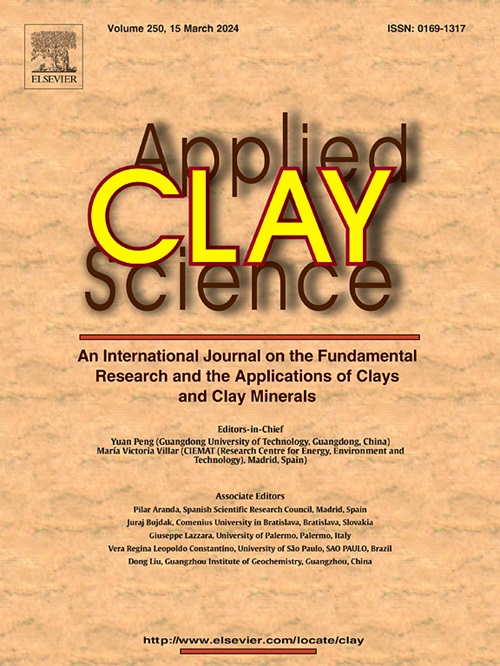Clay minerals formation in MgO-SiO2-H2O low temperature system by hydrothermal synthesis: A study in function of Mg/Si molar ratio and pH
IF 5.3
2区 地球科学
Q2 CHEMISTRY, PHYSICAL
引用次数: 0
Abstract
Magnesium only-phyllosilicates such as serpentines (1:1) and stevensite (2:1) do exist in nature but are not abundant in pure form, whereas synthesized materials can ensure higher purity. Clay mineral hydrothermal synthesis is quite easy to perform, however, the condensation reactions leading to the formation of these phyllosilicates and their precursors are not well understood. Such knowledge would allow to predict the synthesis outcome in case of variation of experimental parameters. This study reports a chemical reaction mechanism explaining the parameters that are determining the type of the formed clay mineral. After a detailed characterization of each obtained phase, it is shown that pH has a lower effect compared to Mg to Si molar ratio. Our results show that above pH 10 the mechanisms of lizardite and stevensite formation are similar with the same elementary units, but that the type of material obtained depends on the availability in excess of magnesium (formation of lizardite) or silicon (formation of stevensite).

水热合成MgO-SiO2-H2O低温体系中粘土矿物的形成:Mg/Si摩尔比和pH的作用研究
自然界中确实存在蛇纹石(1:1)和史蒂文石(2:1)等纯层状硅酸盐镁,但其纯度并不丰富,而人工合成材料可以保证较高的纯度。粘土矿物的水热合成很容易进行,然而,导致这些层状硅酸盐及其前体形成的缩合反应尚不清楚。这些知识将允许在实验参数变化的情况下预测合成结果。本研究报告了一种化学反应机理,解释了决定形成的粘土矿物类型的参数。在对所获得的每个相进行详细表征后,表明pH值对Mg / Si摩尔比的影响较小。我们的研究结果表明,在pH高于10的条件下,蜥蜴石和斯蒂夫石的形成机制相似,具有相同的基本单位,但所获得的材料类型取决于镁(蜥蜴石的形成)或硅(斯蒂夫石的形成)的过量可用性。
本文章由计算机程序翻译,如有差异,请以英文原文为准。
求助全文
约1分钟内获得全文
求助全文
来源期刊

Applied Clay Science
地学-矿物学
CiteScore
10.30
自引率
10.70%
发文量
289
审稿时长
39 days
期刊介绍:
Applied Clay Science aims to be an international journal attracting high quality scientific papers on clays and clay minerals, including research papers, reviews, and technical notes. The journal covers typical subjects of Fundamental and Applied Clay Science such as:
• Synthesis and purification
• Structural, crystallographic and mineralogical properties of clays and clay minerals
• Thermal properties of clays and clay minerals
• Physico-chemical properties including i) surface and interface properties; ii) thermodynamic properties; iii) mechanical properties
• Interaction with water, with polar and apolar molecules
• Colloidal properties and rheology
• Adsorption, Intercalation, Ionic exchange
• Genesis and deposits of clay minerals
• Geology and geochemistry of clays
• Modification of clays and clay minerals properties by thermal and physical treatments
• Modification by chemical treatments with organic and inorganic molecules(organoclays, pillared clays)
• Modification by biological microorganisms. etc...
 求助内容:
求助内容: 应助结果提醒方式:
应助结果提醒方式:


